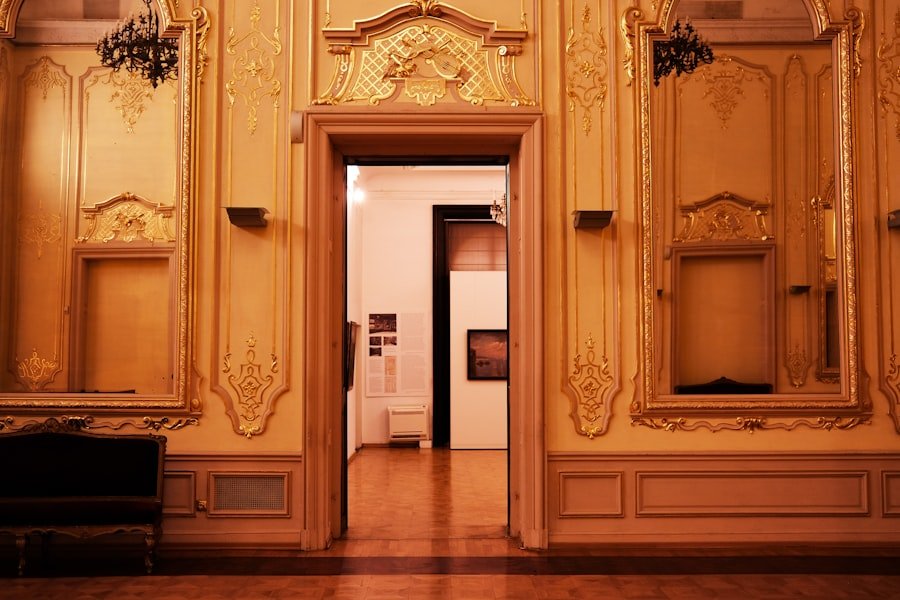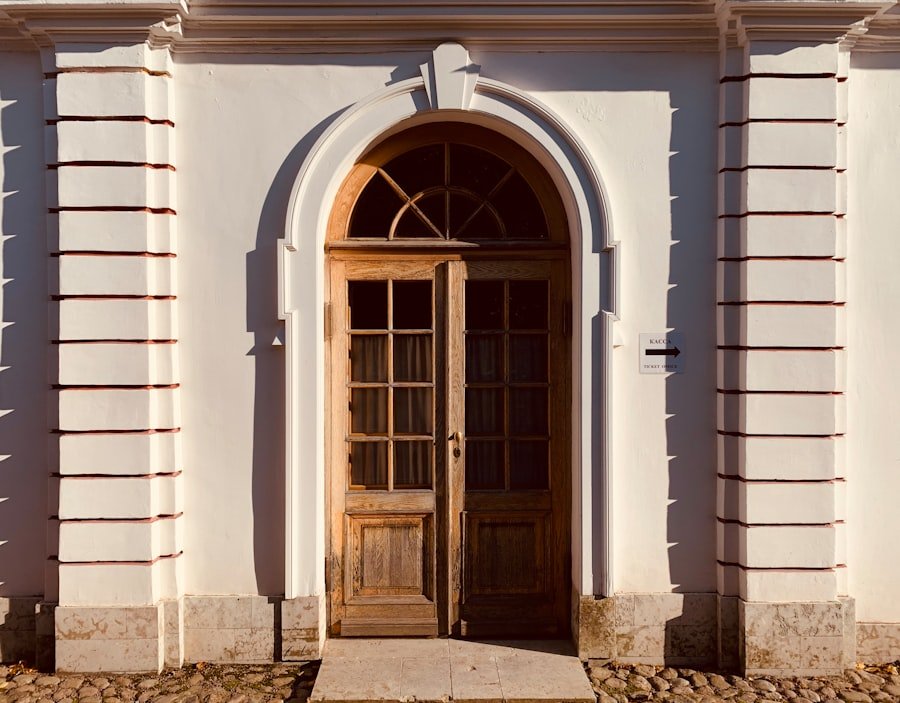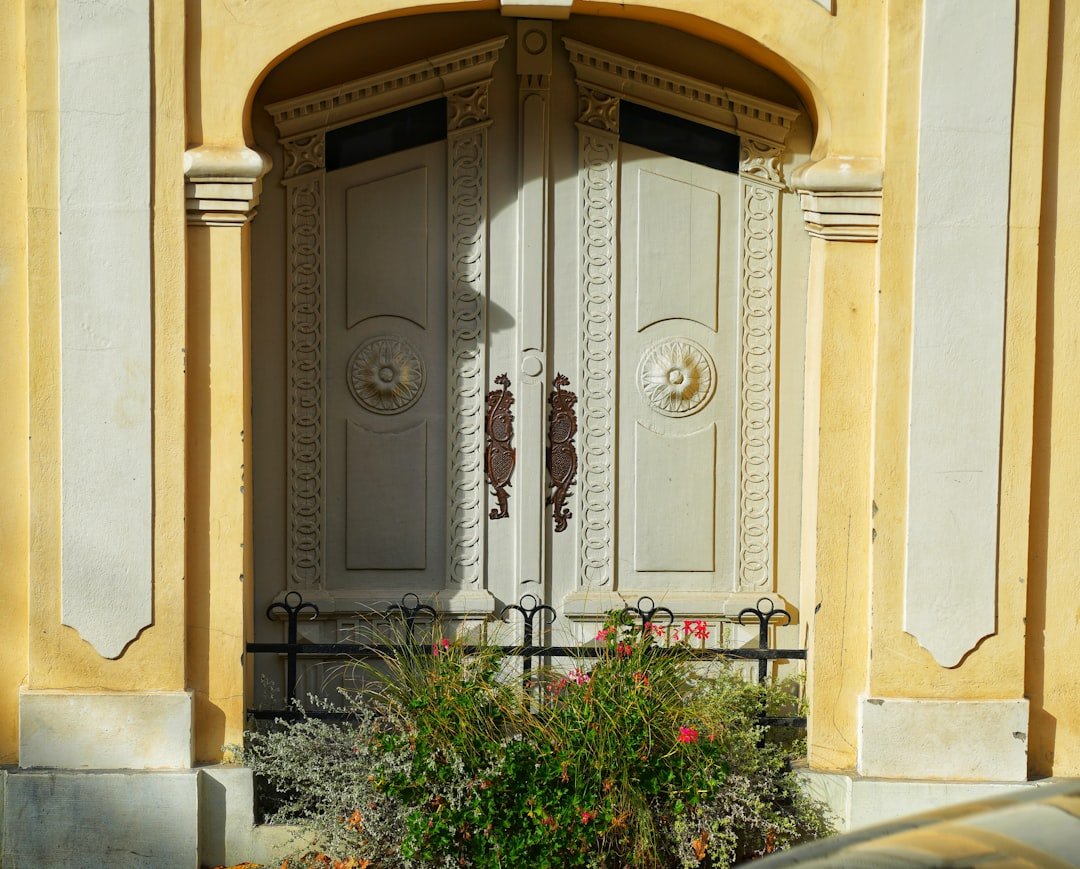This post may contain affiliate links. When you purchase through links on our site, we may earn an affiliate commission.
Art Deco, a design movement that flourished from the 1920s to the 1940s, is characterized by its bold geometric shapes, vibrant colors, and luxurious materials. This style emerged as a response to the more ornate and intricate designs of the preceding Art Nouveau period, reflecting the optimism and modernity of the post-World War I era. Art Deco entryways serve as a striking introduction to the aesthetic, encapsulating the essence of this influential movement.
These portals not only provide access to homes and buildings but also set the tone for what lies beyond, making them a crucial aspect of architectural design. The allure of Art Deco entryways lies in their ability to blend functionality with artistic expression. They often feature grand doors, intricate moldings, and decorative elements that evoke a sense of elegance and sophistication.
As one approaches an Art Deco entryway, they are greeted by a visual feast of lines, patterns, and textures that invite exploration. The significance of these entryways extends beyond mere aesthetics; they symbolize a cultural shift towards modernity and innovation, making them an enduring subject of fascination for architects, designers, and history enthusiasts alike.
Key Takeaways
- Art Deco entryways are known for their bold and geometric designs, and they often feature luxurious materials and intricate details.
- Characteristics of Art Deco design include streamlined forms, geometric shapes, vibrant colors, and lavish ornamentation.
- Iconic Art Deco entryways around the world can be found in buildings such as the Chrysler Building in New York City and the Hoover Building in London.
- Incorporating Art Deco elements into modern entryway design can be achieved through the use of geometric patterns, sleek materials, and statement lighting fixtures.
- Tips for creating a stunning Art Deco entryway include focusing on symmetry, incorporating luxurious materials like marble and brass, and adding bold, graphic patterns to the space.
Characteristics of Art Deco Design
Art Deco design is distinguished by its embrace of modern materials and techniques, which were revolutionary at the time. The use of chrome, glass, and concrete became prevalent, allowing for sleek lines and streamlined forms that defined the era. Geometric patterns are a hallmark of Art Deco, often seen in the repetitive motifs that adorn facades and interiors alike.
These patterns can range from zigzags to chevrons, creating a dynamic visual rhythm that captures the eye and draws attention to the structure. In addition to geometric shapes, Art Deco is known for its lavish ornamentation. While the overall design may be streamlined, it is often punctuated by intricate details such as stylized floral motifs, sunbursts, and animal figures.
These embellishments serve to elevate the design, adding a layer of richness that contrasts with the simplicity of the underlying forms. The color palette of Art Deco is equally striking; bold hues like deep blues, rich golds, and vibrant reds are commonly used alongside softer pastels to create a balanced yet dramatic effect. This combination of modernity and opulence is what makes Art Deco entryways so captivating.
Iconic Art Deco Entryways Around the World

Several iconic Art Deco entryways stand as testaments to the style’s enduring appeal and influence. One notable example is the entrance to the Chrysler Building in New York City. Completed in 1930, this skyscraper features a stunning entryway adorned with intricate metalwork and a grand lobby that showcases the elegance of Art Deco design.
The use of stainless steel and glass creates a luminous effect that captures the spirit of modernity while paying homage to classic architectural elements. Another remarkable example can be found in Miami’s Art Deco Historic District. The pastel-colored buildings lining Ocean Drive feature entryways that embody the playful yet sophisticated nature of the style.
Many of these structures boast rounded corners, neon signage, and decorative tile work that transport visitors back to the glamour of the 1930s. The entryways serve not only as functional access points but also as vibrant expressions of the cultural zeitgeist of their time.
Incorporating Art Deco Elements into Modern Entryway Design
| Elements | Description |
|---|---|
| Geometric Patterns | Incorporate geometric patterns in flooring or wall designs |
| Rich Materials | Use materials like marble, brass, and lacquered wood for a luxurious feel |
| Streamlined Furniture | Choose furniture with sleek lines and metallic accents |
| Statement Lighting | Install art deco-inspired lighting fixtures for a bold focal point |
| Bold Colors | Incorporate bold and contrasting colors for a vibrant look |
Incorporating Art Deco elements into contemporary entryway design can create a unique fusion of old and new aesthetics. One approach is to focus on geometric patterns through flooring or wall treatments. For instance, using patterned tiles or wallpaper with bold shapes can evoke the spirit of Art Deco while maintaining a modern sensibility.
Additionally, incorporating sleek furniture pieces with chrome or glass accents can enhance the overall look without overwhelming the space. Lighting plays a crucial role in achieving an Art Deco-inspired entryway. Opting for fixtures that feature geometric designs or materials like crystal can add an air of sophistication.
A statement chandelier or wall sconces with angular lines can serve as focal points that draw attention to the entryway’s architectural features. By carefully selecting these elements, homeowners can create an inviting atmosphere that pays homage to the elegance of Art Deco while remaining relevant in today’s design landscape.
Tips for Creating a Stunning Art Deco Entryway
Creating a stunning Art Deco entryway requires careful consideration of both design elements and functionality. One essential tip is to prioritize symmetry in your layout. Many Art Deco designs emphasize balance and proportion, so arranging furniture or decor items in a symmetrical manner can enhance the overall aesthetic.
For example, placing matching console tables or decorative mirrors on either side of the door can create a harmonious focal point. Another important aspect is to choose statement pieces that embody the essence of Art Deco. This could include a bold area rug with geometric patterns or an eye-catching piece of artwork that reflects the style’s characteristic motifs.
Incorporating these standout elements will not only elevate the entryway but also provide a sense of cohesion throughout the space. Additionally, consider using mirrors strategically; they can amplify light and create an illusion of space while reflecting the intricate details of your decor.
Materials and Colors for Art Deco Entryways

The choice of materials and colors is pivotal in achieving an authentic Art Deco look in entryways. Luxurious materials such as marble, polished wood, and metals like brass or chrome are quintessential to this style. Marble flooring or wall accents can add an air of opulence, while polished wood can provide warmth and richness to the space.
Incorporating glass elements—whether through doors, windows, or decorative panels—can enhance light flow and create a sense of openness. When it comes to color palettes, Art Deco is known for its bold contrasts and vibrant hues. Deep jewel tones like emerald green, sapphire blue, and ruby red can be paired with metallics such as gold or silver for a striking effect.
Alternatively, softer pastels can be used to create a more subdued yet elegant atmosphere. The key is to strike a balance between boldness and harmony; using accent colors sparingly can help maintain visual interest without overwhelming the senses.
Art Deco Entryway Accessories and Decor
Accessories play a vital role in enhancing the overall aesthetic of an Art Deco entryway. Decorative items such as sculptures or vases featuring geometric shapes can serve as focal points that draw attention while reinforcing the style’s characteristic motifs. Consider incorporating pieces made from materials like crystal or glass to reflect light and add an element of glamour.
Textiles also contribute significantly to the ambiance of an entryway. Luxurious fabrics such as velvet or silk can be used for cushions or drapery to evoke a sense of sophistication. Additionally, incorporating patterned rugs with bold designs can ground the space while adding texture and warmth.
Wall art featuring iconic Art Deco imagery—such as stylized figures or architectural landscapes—can further enhance the theme and create visual interest.
Maintaining the Timeless Appeal of Art Deco Entryways
To maintain the timeless appeal of Art Deco entryways, it is essential to prioritize quality over quantity when selecting furnishings and decor. Investing in well-crafted pieces that reflect the style’s elegance will ensure longevity and relevance over time. Regular maintenance is also crucial; keeping surfaces clean and polished will preserve their beauty while preventing wear and tear.
Moreover, staying true to the core principles of Art Deco—such as symmetry, geometric patterns, and luxurious materials—will help maintain authenticity in your design choices. As trends evolve, it is important to adapt while respecting the foundational elements that define this iconic style. By thoughtfully curating your entryway with attention to detail and an appreciation for craftsmanship, you can create a space that not only honors the legacy of Art Deco but also remains inviting and functional for years to come.
If you’re looking to create a cozy haven inspired by Art Deco style, you may also be interested in exploring beautiful festive decor ideas for every season. This article offers tips and inspiration for incorporating seasonal decorations into your home to create a warm and inviting atmosphere. Check it out here.
FAQs
What is Art Deco style?
Art Deco is a design style that originated in the 1920s and 1930s, characterized by bold geometric shapes, rich colors, and luxurious materials. It is often associated with the glamour and sophistication of the Jazz Age.
What are some common features of Art Deco-inspired entryways?
Art Deco-inspired entryways often feature bold geometric patterns, sleek lines, and luxurious materials such as marble, brass, and glass. They may also incorporate decorative elements such as sunburst motifs, stepped forms, and stylized floral or animal designs.
How can I incorporate Art Deco style into my entryway?
To incorporate Art Deco style into your entryway, consider using geometric patterns, bold colors, and luxurious materials for your flooring, lighting, and furnishings. You can also add decorative elements such as mirrors with geometric frames, sleek console tables, and statement lighting fixtures.
What are some popular color schemes for Art Deco-inspired entryways?
Popular color schemes for Art Deco-inspired entryways include bold and rich colors such as deep blues, emerald greens, and vibrant reds, often paired with metallic accents such as gold, silver, or brass. Black and white color schemes with pops of bold color are also common in Art Deco design.
Where can I find Art Deco-inspired entryway furniture and decor?
You can find Art Deco-inspired entryway furniture and decor at specialty furniture stores, vintage shops, and online retailers that specialize in Art Deco or vintage-inspired furnishings. Additionally, you can look for pieces at antique markets or auctions for authentic Art Deco items.

 using WordPress and
using WordPress and 
No responses yet